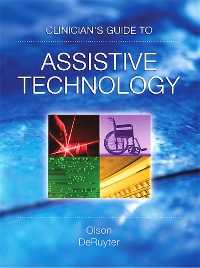Clinician's Guide to Assistive Technology - Elsevier eBook on VitalSource, 1st Edition
by Don A. Olson, PhD and Frank DeRuyter, PhD
Elsevier eBook on VitalSource
ISBN:
9780323062541
Copyright:
2002
Publication Date:
09-25-2001
Page Count:
504
Imprint:
Mosby
List Price:
$80.99
Or $0.00 with a valid access code
The Clinician's Guide to Assistive Technology was designed to provide allied health, clinical and support personnel with specific information about the diverse area of assistive technology. It provides clinical applications to assist the reader in solving problems and gaining options to help the individual who would benefit from these technologies become an active community member. The content of the manual provides a useful adjunct and practical focus for academic materials already available. It is organized around common groupings of technologies, and each chapter addresses specific client functions and abilities, technical options available, level of expertise, and specific goals and ideal applications of the assistive technology. Besides outlining the types of technology that are available, the guide also helps explain the adaptations of the technology and how different technological devices work together.
-
- Diversity of technology areas - covers all major areas and facets of assistive technology, including how the varied technologies can be used in conjunction to improve the ease of activities of dail living for the user
- Organization of text - by grouping assistive technology into four major areas, the book is able to easily lead the reader to both the general area and the specific information they are looking for
- Level of presentation - makes the text useful for both allied health professionals, their support personnel, and even the consumer looking for guidance in the area of assistive technology
- Outstanding group of authors, section editors and contributors representing the country's major programs and each area of assistive technology - provides accurate, up-to-date information for the reader.
-
Section I: Assistive Technology Principles
Introduction
Chapter 1 Matching Consumers Across the Life Span with the Most Appropriate Assistive Technologies
Chapter 2: Contexts: Assistive Technology at Home, School, and Work, and in the
Community
Chapter 3: Human Factors and Environmental Access
Chapter 4: Assistive Technology Service Delivery
Chapter 5: Outcomes
Chapter 6: Funding and Public Policy
Section II: Technologies for Information, Communication and Access
Introduction
Chapter 7: Computer Access
Chapter 8: Information Technologies
Chapter 9: Augmentative/Alternative Communication
Chapter 10: Integrated Systems
Chapter 11: Sensory Aids: Vision
Chapter 12: Sensory Aids: Hearing
Section III: Technologies for Manipulation
Introduction
Chapter 13: Seating Intervention and Postural Control
Chapter 14: Upper Limb Orthotics
Chapter 15: Adaptive Aids
Chapter 16: Upper Limb Prosthetics
Chapter 17: Robotics/Manipulators
Section IV: Technologies for Ambulation and Locomotion
Introduction
Chapter 18: Lower Limb Prosthetics
Chapter 19: Wheelchair Mobility
Chapter 20: Spatial Orientation and Wayfinding
Chapter 21: Driver Evaluation and Vehicle Modification
Chapter 22: Lower Limb Orthotics
Section V: Technologies for Environmental Access
Introduction
Chapter 23: Environmental Access in the Workplace
Chapter 24: Home Environments, Automation, and Environmental Control
Chapter 25: Adaptive Aids for Self-care and Child-care
Chapter 26: Recreation/Play Environments.
-
Don A. Olson, PhD, Associate Professor, Department Physical Medicine and Rehabilitation, Northwestern University Medical Schools; Director, Dixon Education and Training, Rehabilitation Institute of Chicago, Chicago, IL and Frank DeRuyter, PhD, Director and Associate Professor, Speech Pathology and Audiology, Duke University Medical Center, Durham, NC



 as described in our
as described in our 